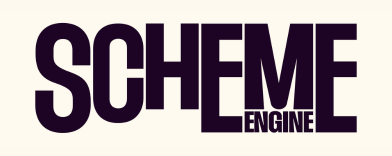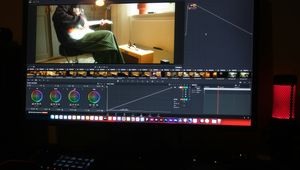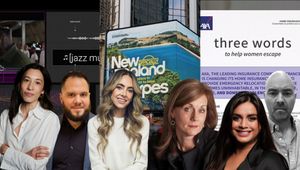
OkayStudio: Taking History, Then Making History for Marshall’s Latest Campaign

In an era that feels like experiencing an information avalanche, creative has to be three things:
- Fully rounded, and yet with edges prominent enough to distinguish it from everything else that surrounds it
- Technically flawless
- Reflective of the society of which it is built to serve
It’s a rarity when a campaign hits all three of these in one. That’s exactly what OkayStudio did working on Marshall’s latest campaign. 'Never Stop Listening' involved creating five thirty-second films featuring unique personalities and their stories. The goal was to convey the core messaging of the brand whilst giving each film its own distinctive visual language with the hope that it would reach fluency.
Taking on a heritage which spans over six decades and is synonymous with a historical movement of rebellion, could not have been an easy feat. Nor could amplifying the voices of cultural pioneers daring to be their authentic selves. The ambitious undertaking meant striking a delicate balance of pushing conceptual limits whilst retaining the unmistakable essence of the Marshall iconic heritage. The multi-layered journey involved weaving together various formats, from 35mm to digital video; in a bid to create something that would not only resonate with Marshall’s past, but act as a signpost directing towards its present and future.
The work is making waves across the waters too, with one spot being shortlisted at this year's Berlin Commercial Awards. We’ll just have to watch this space. In this interview, we hear from OkayStudio editors Jo Lewandowska and Charles Gamble and head of production David Thomas, alongside director Kevin Castanheira on how perseverance, vision, a strong sense of camaraderie, and a little bit of fearlessness, can lead to something quite brilliant.
LBB> Tell us about the original brief and what your initial thoughts were
Charles Gamble> I was excited to work on a Marshall brief as their campaigns always have a distinctive look and feel. The mega-deck was really a MEGA deck. There was a lot in there, but it had a nice balance of thoughtfully planned storyboards and it felt like there was plenty of space for creative freedom in the edit.
Jo Lewandowska> I was very excited when I first saw the brief. Marshall is such an iconic brand and it’s usually associated with rock & roll. This treatment was slightly different and featured four unique personalities including two female protagonists. It wasn’t all about quick cuts and high energy but the message they wanted to convey was important and current. Kevin C has done an amazing job with the previous campaigns so I knew this one was going to be equally great.
Kevin Castanheira> For me it just started with a blank page. Myself and the Creative Director, Andrew Sekora, worked on chiselling the core messaging we wanted to communicate into a tangible campaign with four strong different heroes at the helm. Each film was meant to feel different from one another tonally, as each person featured has their own distinctive voice. We explored different visual approaches and motifs for each giving every person their own visual DNA. Working closely with Ana Projects and the OkayStudio team to create a cohesion in editorial and design but still keeping the heroes' respective qualities intact.
LBB> How did this challenge differ from those that you’ve been set before?
Charles> I’ve never simultaneously shared hero edits with another editor before. Our talent all had varying personalities and stories to tell, but the films needed to be consistent and collectively represent the identities of Marshall. This was a new challenge for me. Me and Jo have quite different backgrounds and editing styles so we needed to come together and find the ‘Marshall’ feel.
Kevin> From the POV of the brands look and feel we stepped into a different medium. Using different visual analogue techniques to support each person’s unique story. I gave the editing team (who smashed it) creative freedom to set the pacing and narrative arc for the films with the intent that each film could and should feel unique from the other films.
Jo> Firstly the campaign was shot with a few different cameras: s16mm, 35mm, DVcam, 16 Bolex to name but a few. We had a lot of great footage to work with. The biggest challenge was finding the right balance and pulling out the best moments to create a coherent story. The second element was keeping in mind animated elements and imagining what the final film will look like. Due to the unique and personalised style of animations which were added after the picture lock, we didn’t quite know how the end product was going to turn out. Charles and I had a lot of conversations to make sure we kept things consistent across all four edits yet different enough to make each film unique.
LBB> Five thirty second films - all integrating their own distinct visual language and sonic nature - seems like a massive feat. How did you strike a balance between pushing the limits of each story conceptually and reminding the audience of the brand’s iconic heritage?
Charles> Finding a sweet spot of how we were showing the product was important. We didn’t want these films to feel too ‘addy’. Therefore selecting shots that subtly showed off the speaker in its environment, that’s the charm of them, they feel authentic and documentary-like, whilst still heavily involving a product in it’s ‘natural’ environment.
Jo> The brief was centred predominantly around the talent and their stories as opposed to the product which gave us quite a lot of freedom in how we approached the edit. The speakers were integrated into each scene in a very casual way to allow our protagonists to shine and show how Marshall is part of their lives.
(I think Charles’ answer really says it all)
Kevin> For me it was just more about following instinct and letting each persons’ personality come through organically and letting that then support the visual language. The voiceover process was interesting because it was very fluid but needed to have the right amount of structure to support our visuals. So creatively that was a hurdle to jump, we couldn’t have the voice over deviate too far from our narrative building blocks but I wanted to create a space where each person’s story could thrive.
LBB> Can you elaborate on the bespoke workflow created by your VFX department? What were the challenges faced in incorporating mixed-media layering techniques into the animation? How did this workflow impact the quality of the final result?
David Thomas> We’ve worked on multiple mixed media projects before, but this campaign required us to rethink our workflow. Firstly, all of our offline editors are well versed in ‘test comps’ which allowed us to set a look and feel early on in the edit process with Kevin. We knew this project would need a bespoke pipeline, in which we could simultaneously pass plates back and forth through offline, over to our animation partners at Ana Projects and into grade, all overseen by our in-house visual effects team. By breaking down the traditional workflow boundary from offline into online, we ensured that both disciplines were in constant contact making us far more streamlined and connected creatively. It’s a great example of how we’re able to provide flexibility for directors and clients.
Kevin> It was tricky! The edit team working simultaneously with the Ana Projects team are all analogue so their process needs time and attention. We would use placeholders in the edit for referencing where the gaps would be filled. Then little by little we filled the gaps and things really started to come together visually. We had to slip some things in the edit but that was always a consideration we were ready to do.
LBB> What were some of the key decisions that had to be made in order to make the campaign a success?
Kevin> Oh boy! I don’t know. I would say there were a lot. Making sure I ate breakfast was a start. Just communicating with all heads of departments. Having a strong relationship with my creative partner Andrew. Day to day meetings with my talented (and somewhat funny) producer Campbell Beaton. Support from my kind EP Harvey Ascott. Working closely with my DOP Cesar Decharme. And of course giving the OkayStudio team support and freedom to do what they do best!
Charles> The use of VO/Sound was massively important. Due to the edits being only 30 seconds, we had such little time to tell our talent’s stories. We ended up treating the sound design in a more abstract method. This included layering up certain words, using one word answers and using certain stems from our chosen music tracks to create not just a script, but a soundtrack to these films.
Jo> Both Sophi and Efron’s stories were completely different in tone and in terms of visuals. One is slower and contemplative the other fast paced and high energy. The message carried in the VO was really important so I wanted to make sure that the edit highlighted key messages of body positivity, female empowerment and inclusivity. We achieved this by layering sound design, music and VO in an interesting and non-linear, non literal-way.
LBB> With three editors working across the same campaign, how did you ensure a cohesive and consistent storytelling experience throughout the films?
Charles> Mine and Jo’s first edits weren’t too far away in style and tone. Both had that authentic Marshall swagger, it was just a case of refining and Kevin feeding back on what he liked and what he didn't. This helped make the edits more consistent.
The use of Ana projects was also hugely important in keeping a cohesive experience. We had to figure out what parts of the edits would benefit from their talents. In each of our edits we left some space for them to have their creative freedom. On top of that, me and Jo supplied Ana Projects with some abstract and textural selects from offcuts of footage we hadn’t used. Ana projects then used those timelines to pull textures, patterns and shapes to integrate within the rest of the edits. This was vital to the success of how these edits lived together.
Kevin> When working with the team I gave them freedom to explore the story structure individually. That approach was really beneficial being that each film was meant to have its own voice. Trying to maintain that Marshall look was pretty simple because I’ve had a long standing creative relationship with the brand. It’s basically second nature.
Jo> Communication is key. Having editors like myself, Charles and Ale feeding off of each other is a great way of working, each of us brought something different to the table. Our individual editing styles come through strongly in the films we each worked on and we would watch each others’ edits every day and exchange ideas, while making sure the style is cohesive across the board. Kevin gave us a lot of freedom in the edit, it was mostly down to our own creativity.
Kevin> It was tricky! The edit team working simultaneously with the Ana Projects team are all analogue so their process needs time and attention. We would use placeholders in the edit for referencing where the gaps would be filled. Then little by little we filled the gaps and things really started to come together visually. We had to slip some things in the edit but that was always a consideration we were ready to do.
LBB> Can you share any specific challenges or hurdles you encountered during the production of the campaign? How did you overcome them and what lessons were taken from the experience?
Kevin> We had so many formats just keeping tabs on all that was time consuming on set and deciding which format to use for what and how. For me I was tasked with shooting a photography element of the campaign so just dividing my time across both motion and stills was a feat. As well as playing a creative role in the project. Lots of different hats!
Charles> Due to the shoots being worldwide, there was A LOT of footage coming at various times, in various formats…stills, 360, films scans, VHS etc. This meant that we had to stay sharp on what was coming in and how we were organising it. Massive credit goes to our amazing edit assistants who managed this brilliantly.
This led into the next challenge… having hours of beautifully shot material but only having the short space of 30 seconds to squeeze it all in. I’m pretty sure my first cuts were around the 1 min 30 mark. Therefore we had to be brutal with what we wanted to keep. If it was going in the edit, it had to be golden.
LBB> What do you believe sets these experimental films apart from other brand campaigns in terms of their visual language and sonic signature?
Kevin> They feel representative of each hero’s voice whilst maintaining that Marshall spirit. There’s some underlined messaging that the brand supports peoples voices. We discussed a myriad of issues from mental health to self image.
Jo> I think the sheer amount of different creative ideas encapsulated in each of the campaign films is impressive. Not only is it true to Marshall brand and its distinct visual language but it sends a positive message and provides us with a window into the talent’s minds. It’s a perfect example of brand advertising that’s not afraid to experiment and push the boundaries in a fresh and unique way.
LBB> Looking back at the entire process, what aspects of the campaign are you most proud of? And what (if anything) would you do differently?
Jo> Honestly, the whole process was extremely enjoyable and wild at times due to the challenging workflow. Our entire team (especially production and assistants) pulled together and supported us from the beginning to the end. Very proud of the OkayStudio team for being the most patient, flexible and passionate bunch of people I’ve ever had the pleasure to work with. The campaign success is a testament to that.
Charles> Everything. Was a proper OkayStudio team effort. I’m proud of how we brought four very different personalities together across each of the hero films, whilst keeping a consistent brand identity and style.
Kevin> Finishing it! The brief came in August 2022 so I was very happy to finally see it go out in the world.















